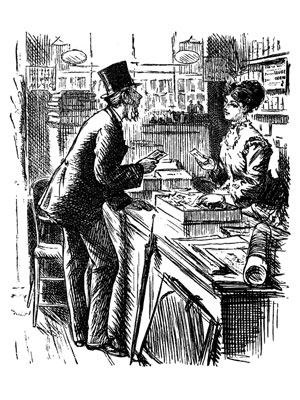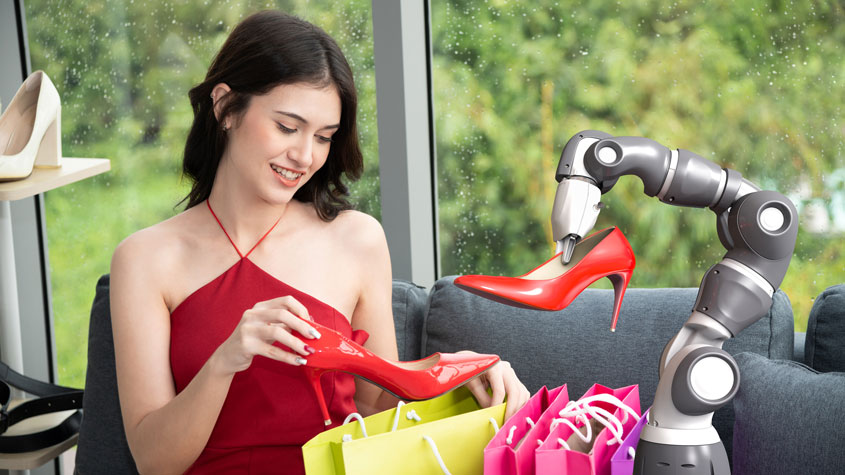
Trademark Law Playing Catch-up with Artificial Intelligence?
By Lee Curtis, and Rachel Platts, Chartered Trademark Attorneys at HGF, Manchester, United Kingdom
Artificial intelligence (AI) has the potential to impact all aspects of how we live and currently is a subject of great debate. However, despite extensive press commentary on AI and its alleged revolutionary impact, its influence on our lives in the short term is likely to be relatively limited.

As noted by the American researcher and futurist Roy Amara, “We tend to overestimate the effect of a technology in the short run and underestimate the effect in the long run.”
The long-term impact of AI on how consumers buy products and services and the knock-on impact on trademark law has often been overlooked. Most commentators tend to concentrate on the impact that AI will have on patent, copyright and design law.
How we buy products: changes over time

law were formulated, the shop assistant would advise
consumers on which product to buy, providinga “filter”
between the consumer and the product, which was
largely unbranded. (Photo: benoitb / Getty Images)
You might presume that how we buy products and services has not changed over time, but that is not the case; the way we purchase products and services has changed constantly over the years.
Consider the way people bought products in the nineteenth century when the basic tenets of trademark law were formulated. This, no doubt, evokes an image of a traditional Victorian shop, with a shop assistant standing in front of a selection of wares in glass cabinets. At that time, the shop assistant provided a “filter” between the consumer and the product, which was largely unbranded. The assistant was the only actor in the process with knowledge of the products on sale and would typically offer the consumer advice on which product to buy.
The long-term impact of AI on how consumers buy products and services and the knock-on impact on trademark law has often been overlooked.

made the decision alone and no longer benefitted from
a filter (the shop assistant) between the consumer and
the product because all available products were visible.
(Photo: George Marks / Getty Images)
The Victorian mode of buying product significantly changed with the advent of the modern supermarket, where the consumer made the decision alone and no longer benefitted from a filter (the shop assistant) between the consumer and the product. Moreover, in this context, the consumer was aware or could become aware of all the products on sale in the supermarket, because all available products were visible to the consumer in the shop.
Then, with the rising prominence of product branding, the consumer gained additional information from direct brand cues, either in the form of the phonetics of brands or their visual or conceptual impact. In the modern supermarket, brands effectively replaced the Victorian shop assistant and essentially took on the role of communicating with consumers directly.
The Internet further changes purchasing habits

consumer with the “likes” of family and friends becoming an important
factor in purchasing decisions. (Photo: Elena Brovko / Getty Images)
The purchasing process changed again with the introduction of Internet shopping. The products available to the consumer increased exponentially and with it, the product information and knowledge of the consumer. Again, there was no filter between the consumer and the product; the consumer was in complete control of the purchasing decision.
The social media revolution introduced new forms of influence on the consumer with the “likes” of family and friends becoming an important factor in purchasing decisions. “Likes” gained additional importance, as “outside” influencers such as celebrities and sports stars entered the scene.
The purchasing process is affected by information available to the consumer and who, or indeed what, makes the purchasing decision. AI has an impact on the information available to consumers and their purchasing decisions.
The structure of the purchasing process is changing again, arguably, with the introduction of AI applications such as Amazon Alexa, Google Home, consumer chatbots, AI personal shopping assistants, such as Mona, Amazon Dash and AI robot assistants, such as Pepper. In many ways, the introduction of AI applications has meant that the purchasing process has reverted back to the old Victorian model, with some important differences.

AI’s influence on buying decisions
Although the use of AI applications by consumers is still relatively limited, most consumers will have used some form of AI application, such as the product recommendation system appearing on Amazon.com and other online retail platforms. In this context, the AI application effectively acts as a filter between the consumer, the product and the brand, making unique recommendations to the consumer on the basis of past purchasing decisions.
AI applications also have important implications for who is considered to be the “average consumer” in trademark infringement proceedings and issues of liability.
Many consumers do not delegate the purchasing decision to an AI application like Amazon Alexa. However, insofar as the AI application (and not the consumer) has access to all available information about the products on sale, the AI application is akin to a personal shopper. In this respect, it is possible that the consumer may completely delegate the purchasing decision to the AI application, with the AI application making that decision principally on the basis of the past purchases of the consumer.
In an article in Harvard Business Review in May 2019, Nicolaj Siggelkow and Christian Terwiesch refer to such a product offering as an “automatic execution” model. In an earlier article, in October 2017, in the same publication, the automatic execution model was referred to by authors Ajay Agrawal, Joshua Gans and Avi Goldfarb, as turning the traditional purchasing process on its head from a “shopping-then-shipping” model to a “shipping-then-shopping” model. Retail is no longer purely “responsive” to the consumer’s demands; in the age of AI, it has become “predictive retail.”

The predictive retail model is still in its infancy. To have true traction such retail models must be sufficiently accurate to avoid the economic problem of large-scale returns, which is already bedeviling the fast fashion sector. This retail model, however, raises interesting questions with regard to concepts of trademark law, such as “post-sale confusion” and the like. If a human has no part in the purchase of a branded product, then by definition the human can only be confused at the point of receipt of the product, not at the point of sale. The conventional form of post-sale confusion concerns third parties, not the purchaser, but predictive retail could herald a new form of post-sale confusion by the consumer.
Even where consumers have not delegated the purchasing decision to an AI application, AI has an impact on the way the consumer views the market, products and brands because, on average, an AI application, such as Amazon Alexa, recommends three products to the consumer when prompted to search for a product to buy. The consumer is not aware of the full range of products available on the market and is thus met with a relatively limited set of products to purchase, even if ultimately, he or she makes the purchasing decision. The AI application again forms a filter between the consumer and the brand.
So, what has this to do with trademark law?
The scenario outlined above has significant implications for trademark law and its application. Afterall, trademark law concerns the purchasing process, how products are bought and the interaction between the consumer and the brand.
The purchasing process is affected by information available to the consumer and who, or indeed what, makes the purchasing decision. AI has an impact on the information available to consumers and their purchasing decisions.
AI in the retail context also raises important questions with regard to comparative advertising and regulations relating to influencers.
Moreover, trademark law is fundamentally based on concepts of human frailty. When you take the “human” and the “frailty” out of trademark law what are you left with?
Some of the basic tenets of trademark law concern aspects of human frailty, such as “imperfect recollection”, “confusion”, the “slurring of trademarks” and the aural, conceptual and visible impact and comparison of trademarks. These aspects of trademark law were heightened with the rise of supermarket shopping, but are likely to become less important with the rise of AI due to the reduced product choice, or at least reduced product and brand choice, individual consumers are presented with.
AI applications also have important implications for who is considered to be the “average consumer” in trademark infringement proceedings and issues of liability. If an AI application purchases a product, with little or no human interaction, who or, more importantly, what is the average consumer and who or what is liable for a purchase which leads to trademark infringement?
Case law relating to AI and trademark infringement
Although there have been no cases to our knowledge which have directly dealt with the issue of AI and liability in trademark infringement, a number of cases over the past decade before the Court of Justice of the European Union (CJEU) could be applied in light of this new technology to shed some light on this question.
The Louis Vuitton v Google France decision, which concerned the issue of keyword advertising and the automatic choice of such keywords in Google’s AdWords system, held that Google would not be liable for trademark infringement unless they took an active part in the keyword advertising system. Further, L’Oréal v eBay, which concerned the sale of counterfeit goods on eBay’s online marketplace similarly held that eBay would not be liable for trademark infringement unless they were actively aware of the infringing activity. A similar reasoning was followed in the Coty v Amazon case. It would therefore appear that if an AI application provider had in place sufficient take down procedures akin to those described in the Google and eBay cases, and were not on notice of infringing activity, then they would not be held liable for infringing activity.
However, where the AI provider is more involved in any potential infringing activity, two cases suggest that liability could be found by the AI provider. In Cosmetic Warriors Ltd and Lush Ltd v Amazon.co.uk Ltd and Amazon EU Sarl before the United Kingdom High Court, Amazon were found liable for infringement in the use of trademarks which triggered links to its website that did not encompass the branded product referenced, such that the consumer could not tell whether the products on sale were those of the brand owner or not. Further, a series of cases before the Federal German Court concerning Ortlieb Sportartikel GmbH held Amazon liable where ads on Amazon.de were triggered by the use of the search term “Ortlieb,” on the basis of its use in product descriptions as well as on the basis of past consumer behavior, a key aspect of AI applications. The courts reasoned that consumers would have been “conditioned” in the expectation that Ortlieb and only Ortlieb products were being sold. There has been speculation most notably by Markus Rouvinen on the IP Kat blog that such logic could be applied to so-called online product listing ads (PLA's) where the search provider actively triggers ads based on past search behavior, which is akin to past consumer purchasing behavior,one of the main drivers of AI-based purchasing suggestions and decisions.
AI and comparative advertising: considerations
AI in the retail context also raises important questions with regard to comparative advertising and regulations relating to influencers. By definition an AI application, such as Amazon Alexa, is an “influencer”. On average, Alexa recommends three potential products to the consumer to purchase, typically, the brand leader, Amazon’s own brand and a product influenced by the consumer’s past-purchasing decisions. Even if an AI application itself is not delegated to make the purchasing decision, by definition, it does “influence” that decision. If that is held to be the case, should AI applications be governed by the regulatory framework relating to influencer marketing?

In such a case, product suggestions by an AI application would need to be clearly identified as a promotion of some sort. This issue would be of increased importance if the AI application were to make product recommendations based on criteria that benefit the AI provider, such as profit margins on product, as opposed to those directly linked to the consumer’s past preferences.
Further, there is the potential for AI applications to engage in comparative advertising. If a consumer asks an AI application for a product, there is the potential for the application to suggest an “alternative” product to the consumer for a fee paid by a competing product supplier. This raises comparisons to online keyword advertising where issues of comparative advertising have arisen in the bidding process for keyword search terms.
Voice search gains traction: implications for trademarks
The potential for searching by voice, which the rise of AI applications heralds, has not been overlooked by the advertising sector. Some predict that between 30 and 50 percent of product searches will be conducted by voice as opposed to text within five years. Although these predictions may be overblown, it is likely that certain areas of the retail market, such as the consumables market, will be significantly impacted by voice search.

The introduction and rise of bidding on voice-search terms will raise the same issues as have been encountered with regard to text searching. Also, as voice search overtakes text search, the balance between the phonetic, visual and conceptual comparison of trademarks will change. The visual aspects of a trademark will decline in importance with greater emphasis on phonetic and conceptual comparison. Such a change is not unlike that which occurred when the Victorian shopping model gave way to supermarket shopping.
Furthermore, although not ultimately decided on the issue of comparative advertising, Justice Arnold, in the keyword advertising case, Interflora v Google in the UK, did express surprise that the EU Directive on misleading and comparative advertising (Directive 2006.114/EC) had not been raised in that case. Maybe a case concerning an AI application engaged in comparative advertising will deal with this issue head on.
So where are we now?
AI may not have the short to medium impact on the world that is feared or hoped for by recent press interest, but it is coming. One area where the impact of AI could be pronounced potentially is in the way product is bought, which by definition has significant implications for trademark law. As Humphrey Bogart might have said to Ingrid Bergman in an updated version of Casablanca: AI is changing trademark law, maybe not today, maybe not tomorrow, but soon and for the rest of your life.
WIPO, IP and AI
As policy makers across the globe start to make sense of the wide-ranging impacts of artificial intelligence on the economy and society, WIPO and its member states have started to engage on the aspects of AI that are specific to intellectual property (IP), both in terms of its impact on IP administration and on IP policy. Following the First Session of the WIPO Conversation on IP and AI, in September 2019 and an AI and IP Policy Public Consultation, from December 2019 to February 2020, WIPO has developed a revised issues paper on IP and AI, including in relation to trademark law, which will be discussed at the Second Session of the WIPO Conversation on IP and AI from July 7 to 9, 2020.
The WIPO Magazine is intended to help broaden public understanding of intellectual property and of WIPO’s work, and is not an official document of WIPO. The designations employed and the presentation of material throughout this publication do not imply the expression of any opinion whatsoever on the part of WIPO concerning the legal status of any country, territory or area or of its authorities, or concerning the delimitation of its frontiers or boundaries. This publication is not intended to reflect the views of the Member States or the WIPO Secretariat. The mention of specific companies or products of manufacturers does not imply that they are endorsed or recommended by WIPO in preference to others of a similar nature that are not mentioned.